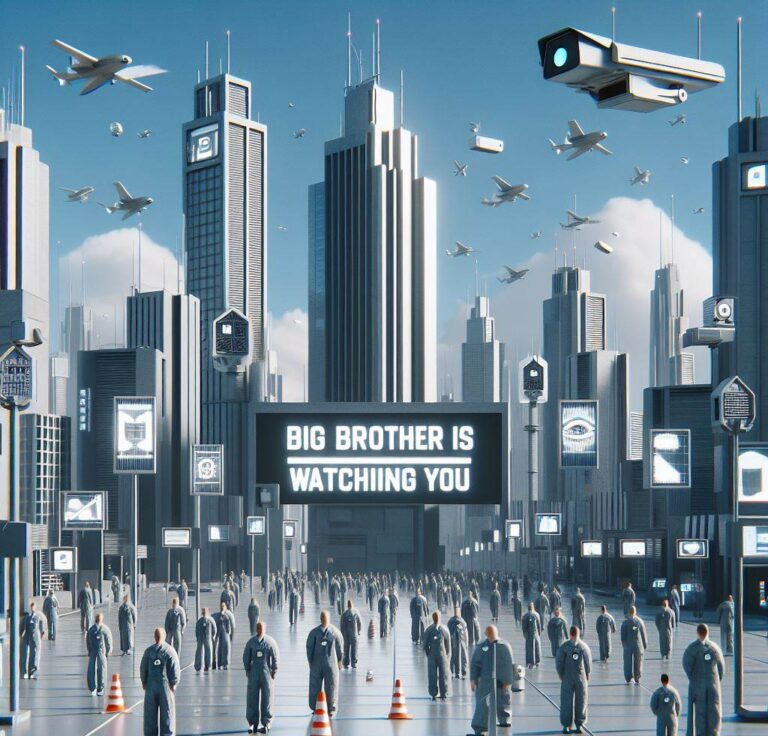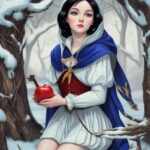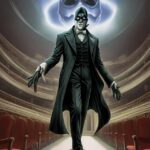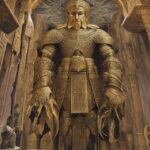Step into a world where reality is manipulated, freedom is an illusion, and truth is no longer absolute. George Orwell’s visionary masterpiece, 1984, transports us to a dystopian society ruled by an oppressive regime that exerts mind-bending control over its citizens. This captivating novel, shaped by Orwell’s keen insights and uncanny foresight, has not only withstood the test of time but has become a chilling reminder of the perils that lie beneath the surface of any society.
In this meticulously crafted summary, we embark on a journey to dissect the intricate layers of Orwell’s 1984, delving into the dark recesses of its plot, characters, and themes. By unlocking the kindred essence of the book’s historical context and Orwell’s own experiences, we will unravel the underlying message that continues to captivate and rouse readers globally.
Join us on this enthralling journey as we navigate through the haunting corridors of Oceania, where Big Brother surveils your every move, language is manipulated, and individualism is punishable. Brace yourself for a truly mind-altering experience as we analyze the eternal questions that Orwell’s 1984 poses, offering profound insights into the complexities of power, control, and the indomitable spirit of human resistance.
1984 by George Orwell: Full Book Summary
Once upon a time, in the not-so-distant future, there was a world called Oceania where Big Brother reigned supreme. This is the story of a boy named Winston Smith who lived a life that was tightly controlled and monitored by the government. The year was 1984, and life as they knew it was about to change forever.
Winston lived in a city called London, which was part of the country known as Airstrip One. Airstrip One was one of three superstates that included Eastasia and Eurasia. These superstates were in a perpetual state of war, each trying to gain power over the others. The Party, led by Big Brother, controlled every aspect of life, ensuring absolute loyalty and conformity from its citizens.
The Party’s grip was so tight that even thoughts of rebellion were considered criminal. Televisions called telescreens were installed all over the city, watching and listening to citizens at all times. The Thought Police were always on the lookout for anyone who dared to have thoughts against the Party. Winston harbored secret doubts and dreams of a better life, and he knew he had to be careful.
Winston worked for the Party in the Ministry of Truth, where he helped rewrite records and historical documents to fit the Party’s narrative. However, deep down, he knew that the Party’s version of truth was not the real truth. He longed to uncover the past and learn what life was like before Big Brother’s rule.
One day, Winston met a woman named Julia, who worked in the Fiction Department at the Ministry of Truth. They began to secretly meet and explore their forbidden desires. Their relationship blossomed in hideaways and abandoned places, knowing that their love was an act of rebellion against the Party. They dreamt of bringing down the oppressive regime and creating a world where love and freedom would prevail.
Winston knew that in order to destroy the Party, he had to join the mysterious Brotherhood led by a man named Emmanuel Goldstein. The Brotherhood was a secretive organization dedicated to overthrowing Big Brother. Winston believed that Goldstein’s book, ‘The Theory and Practice of Oligarchical Collectivism,’ held the key to liberation.
But as Winston delved deeper into his rebellious activities, he became increasingly paranoid. He suspected that his every move was being watched, and he feared the inevitable consequences of his dissent. Winston’s fears turned out to be true when he was caught by the Thought Police and brought to the dreaded Ministry of Love for interrogation.
In the Ministry of Love, Winston faced the sinister O’Brien, a member of the Inner Party and a loyal servant of Big Brother. O’Brien used a variety of torture techniques to break Winston’s spirit and make him surrender to the Party. Winston’s once fiery desire for freedom began to wane under the relentless pressure.
As the torture continued, Winston’s love for Julia crumbled, and he betrayed her, not being able to take the pain any longer. He embraced the Party’s ideology and declared his undying love for Big Brother. In that moment, Winston was broken, his spirit crushed by the Party’s brutality.
The story ends with Winston’s complete transformation. He no longer had any thoughts of rebellion or hope for a better future. He had become a loyal, obedient citizen of Oceania, just like everyone else. Big Brother had won, and the Party’s control over its citizens remained unchallenged.
‘1984’ serves as a cautionary tale, reminding us of the dangers of unchecked power and government surveillance. It highlights the importance of individuality, freedom of thought, and the relentless pursuit of truth. While Winston’s story may be bleak and tragic, it serves as a reminder to cherish and protect the freedoms we have and to never take them for granted.
So dear little readers, remember to question everything, to challenge authority when it becomes oppressive, and to cherish the freedom of thought and expression that we are blessed to have. And perhaps, just perhaps, we can prevent a future where the thought police invade our minds and Big Brother watches our every move.
1984: Key Themes
“1984” by George Orwell is a dystopian novel set in a totalitarian regime. It explores themes of control, manipulation, and the loss of individual freedom.
1. Control:
One of the most prominent themes in “1984” is the overwhelming control exercised by the Party. In this authoritarian society, the Party governs every aspect of people’s lives, using surveillance and manipulation to maintain power. The Party controls information, rewriting history to fit its narrative and manipulating language through Newspeak, an attempt to eliminate independent thought. Through the protagonist, Winston Smith, we witness the Party’s control over thoughts, actions, and even emotions, as every citizen is constantly monitored by the omnipresent telescreens. The theme of control highlights the potential dangers of a government with unlimited power and the erosion of individual autonomy.
2. Manipulation:
The novel also delves into the theme of manipulation. The Party manipulates reality by altering historical records and distorting the truth, creating a false narrative that supports its authority. Winston’s job at the Ministry of Truth involves rewriting historical documents to suit the Party’s changing agenda, illustrating how the past can be manipulated to control the present. The Party also manipulates its citizens through surveillance, fear, and propaganda. It uses the concept of doublethink, where individuals are forced to simultaneously hold contradictory beliefs, incapacitating their ability to think critically. The theme of manipulation serves as a warning about the dangerous consequences of allowing those in power to control information and shape reality to suit their interests.
3. Loss of Individual Freedom:
Central to “1984” is the theme of the loss of individual freedom. In Oceania, every aspect of personal life is controlled and monitored by the Party. Citizens are denied the freedom of thought, expression, and privacy. Independent thinking and dissenting opinions are considered thought crimes and ruthlessly suppressed. The Party’s goal is to erase individuality and create a society of mindless obedience. Winston’s rebellion against this loss of freedom serves as a symbol of resistance and desire for autonomy. The theme of the loss of individual freedom raises questions about the importance of freedom of thought, expression, and the potential consequences of its absence.
Overall, “1984” serves as a cautionary tale about the dangers of unchecked power, control, manipulation, and the loss of individual freedom. Orwell’s portrayal of this dystopian society remains relevant in today’s world, reminding us of the importance of safeguarding our rights and being vigilant against any attempts to manipulate or limit individual autonomy.
1984: Characters
1. Winston Smith: The protagonist of the story, Winston is a middle-aged man who works at the Ministry of Truth, where he alters historical records to align with the Party’s propaganda. He has a thin and frail physique, with a Winston Churchill-like appearance. Interestingly, he possesses a small birthmark resembling the number 19, symbolizing his rebellious nature and desire for freedom.
2. Julia: A young woman who works at the Fiction Department, Julia is described as having vibrant, waist-length blonde hair and bright blue eyes. She appears innocent and obedient, but her true rebellious and passionate nature is revealed when she initiates an affair with Winston. Apart from her secret escapades, she is known for sneaking chocolate and real coffee, which are considered luxurious, forbidden items in the dystopian society.
3. O’Brien: A high-ranking member of the Inner Party, O’Brien is portrayed as an intelligent and charismatic figure. With his salt and pepper hair and intense dark eyes, he exudes an air of authority. O’Brien initially poses as a collaborator and gains Winston’s trust before revealing himself as a staunch supporter of the Party. His robust physical presence and strategic manipulations make him a formidable adversary.
4. Big Brother: Though never seen in person, Big Brother is the enigmatic, all-powerful figurehead of the Party. Thought to be the embodiment of the Party’s ideals, he is represented through ubiquitous posters displaying a handsome, middle-aged man with a stern expression. Rumors circulate that Big Brother may not even exist, but the fear he instills in the citizens is very real. Hinting at a paradoxical twist, some speculate that Big Brother might be Winston himself.
5. Syme: A colleague of Winston’s in the Ministry of Truth, Syme is a highly intelligent but naive individual. With his unnaturally large ears and tendency to mutter to himself, Syme is notable for his elaborate vocabulary and love for Newspeak, the Party’s language of ultimate control. Unfortunately, his enthusiasm for creating the ultimate form of Newspeak ultimately leads to his disappearance, reinforcing the Party’s ruthless tactics.
6. Parsons: A member of the Outer Party and a neighbor of Winston’s, Parsons symbolizes the blind loyalty and conformity ingrained in the society. With a pudgy build and receding hairline, he is a middle-aged man who constantly boasts about his children’s loyalty to the Party. Ironically, Parsons is arrested by the Thought Police solely due to the false accusations made by his own daughter, illustrating the paranoia and manipulation within the dystopian world.
7. Mr. Charrington: A seemingly harmless old shop owner, Mr. Charrington runs a junk shop in a prole district. He has a frail physique, a long white beard, and faded blue eyes that twinkle with mischievousness. Unbeknownst to Winston and Julia, Mr. Charrington is revealed to be a member of the Thought Police, betraying their trust and leading to their capture. His deceptive appearance highlights the pervasive surveillance and betrayal prevalent in the Party’s regime.
Through these vivid character descriptions, George Orwell’s haunting dystopian world in “1984” comes to life, each character contributing to the overarching themes of surveillance, rebellion, and the manipulation of truth.
1984 by George Orwell: Symbols
1. Big Brother:
Big Brother is the central symbol in the book and represents the all-powerful and totalitarian Party. He is depicted as an omnipresent and omniscient figure who is always watching over the citizens of Oceania. Big Brother symbolizes the complete control and surveillance the Party exercises over every aspect of people’s lives, indoctrinating them into blind loyalty and conformity. His image is plastered everywhere, and the slogan “Big Brother is Watching You” serves as a constant reminder of the Party’s dominance.
2. The Thought Police:
The Thought Police symbolize the Party’s control over thoughts and ideas. They are portrayed as an intimidating and covert force that monitors and punishes any form of unorthodox thinking or rebellion against the Party. The symbol of the Thought Police reflects the constant fear and paranoia that is instilled in the citizens of Oceania, making them censor their own thoughts and conform to the Party’s ideology. The presence of the Thought Police also represents the extent to which the Party will go to maintain its power and eradicate any opposition.
3. Newspeak:
Newspeak is the official language of Oceania, created by the Party to limit freedom of expression and independent thought. It is a highly simplified language that aims to eliminate words and concepts that could be used for critical thinking or dissent. Newspeak symbolizes the Party’s effort to control and manipulate the thoughts and opinions of its citizens. By limiting the range of words and concepts available, the Party effectively limits the ability of individuals to question or articulate ideas that challenge the Party’s control. The existence of Newspeak signifies the Party’s desire for total control over language and the suppression of individuality.
1984: Culture Impact
George Orwell’s iconic novel, 1984, holds an undisputed position as one of the most influential literary works of the 20th century. Published in 1949, Orwell’s dystopian masterpiece delves into the sinister realms of totalitarianism, surveillance, and the erosion of individual freedoms. The impact of 1984 on culture has been far-reaching, leaving an indelible mark on both literary and social spheres.
Historically, 1984 played a significant role in shaping public perceptions of government control and manipulation. Orwell’s vivid depiction of a world divided into three totalitarian superstates—Oceania, Eurasia, and Eastasia—captivated readers’ imaginations and served as a chilling prophecy of the future. The novel’s portrayal of an omniscient Big Brother, constantly monitoring citizens through telescreens and Thought Police, resonated with the fear of government intrusion felt during the rise of authoritarian regimes throughout the 20th century.
Funny enough, many aspects of Orwell’s dystopia have found their way into modern discourse and popular culture. Terms coined in the novel such as “doublespeak,” “thoughtcrime,” and “Big Brother” have become common phrases used to critique deceptive political language and the omnipresence of surveillance. The concept of a “Room 101” in which individuals are subjected to their worst fears has become synonymous with torment and psychological manipulation.
1984’s exploration of power dynamics and the manipulation of truth has also influenced various artistic mediums. Films, music, and even advertising campaigns have drawn inspiration from Orwell’s themes, illustrating the profound cultural impact of the novel. Countless works of literature and science fiction owe a debt to Orwell’s groundbreaking exploration of dystopia, which has become a touchstone for authors tackling similar topics.
Beyond cultural impact, 1984 has achieved several notable achievements. The novel has sold millions of copies worldwide, with continuing high demand, solidifying its status as an enduring classic. Orwell’s masterful storytelling and prophetic vision have ensured that 1984 remains relevant across generations, making it a staple in educational curricula globally.
Moreover, the book has become a symbol of resistance and individualism. Its portrayal of Winston Smith’s attempt to maintain his humanity under the oppressive Party has inspired countless activists, dissidents, and proponents of free speech. The novel’s ability to ignite conversations around privacy, government surveillance, and the nature of truth demonstrates its ongoing significance in shaping societal discourse.
In summary, Orwell’s 1984 has left an undeniable cultural impact that reverberates to this day. Through its blend of historical context, dark humor, and visionary achievements, the novel has become a touchstone for understanding the dangers of unbridled power and the fragility of individual liberties. As the world continues to grapple with issues of surveillance and government control, the relevance and influence of Orwell’s masterpiece only continue to grow.
FAQs
1. Who wrote the book “1984”?
The book “1984” was written by George Orwell.
2. What is the main plot of the book “1984”?
“1984” is a dystopian novel that depicts a totalitarian society ruled by a party led by Big Brother. The story follows Winston Smith, a low-ranking member of the party, who begins to question the principles of the party and rebels against its oppressive regime.
3. When was the book “1984” published?
The book “1984” was published in 1949, just a few years after World War II.
4. What are the major themes explored in “1984”?
“1984” explores themes such as totalitarianism, government surveillance, manipulation of truth, individualism versus collective identity, and the dangers of a society devoid of privacy and freedom.
5. Why is “1984” considered a classic and influential novel?
“1984” is considered a classic and influential novel because it warns about the dangers of totalitarianism and the abuse of power. Its portrayal of a future society controlled by the government resonates with readers, and its ideas and concepts about surveillance and control have become a part of popular culture. The book’s impact extends beyond its publication, as it continues to inspire critical discussions on the nature of society and government.
6. Why is the war in 1984 never ending?
The war in 1984 is never ending because it serves the purpose of the Party to keep the population in a state of fear, ignorance, and obedience. The war also consumes the surplus resources and prevents the rise of living standards, which could threaten the Party’s control. The war is not meant to be won, but to be continuous.
7. Why is the photo of Jones, Aaronson, and Rutherford important?
The photo of Jones, Aaronson, and Rutherford is important because it is a piece of evidence that contradicts the Party’s version of history. The photo shows that the three men, who were executed as traitors, were actually in New York at the time they were supposed to be in Eurasia. The photo proves that the Party lies and manipulates the past.
8. Is Julia a spy working with the Thought Police?
Julia is not a spy working with the Thought Police, but a genuine rebel who hates the Party and its oppression. She uses her sexual attractiveness to lure men like Winston into her secret life of rebellion. She is not interested in the political or ideological aspects of the resistance, but only in the personal and emotional ones.
9. Can Winston and O’Brien read each other’s minds?
Winston and O’Brien cannot read each other’s minds, but they have a strong connection based on their shared hatred of the Party and their desire for freedom. They both recognize each other as potential rebels and allies, and they communicate through subtle gestures and hints. However, their connection is ultimately a deception, as O’Brien is actually a loyal member of the Party and a spy who betrays Winston.
10. How is Julia’s rebellion against the Party different than Winston’s rebellion? Julia’s rebellion against the Party is different than Winston’s rebellion in that it is more practical and less intellectual. Julia does not care about the truth or the history of the Party, but only about finding ways to enjoy life and escape the Party’s surveillance. She is not interested in joining the Brotherhood or overthrowing the Party, but only in having fun and expressing her individuality. Winston, on the other hand, is more concerned with the philosophical and political implications of the Party’s rule, and he wants to understand the nature and purpose of its tyranny. He is willing to join the Brotherhood and risk his life for the cause of freedom.










